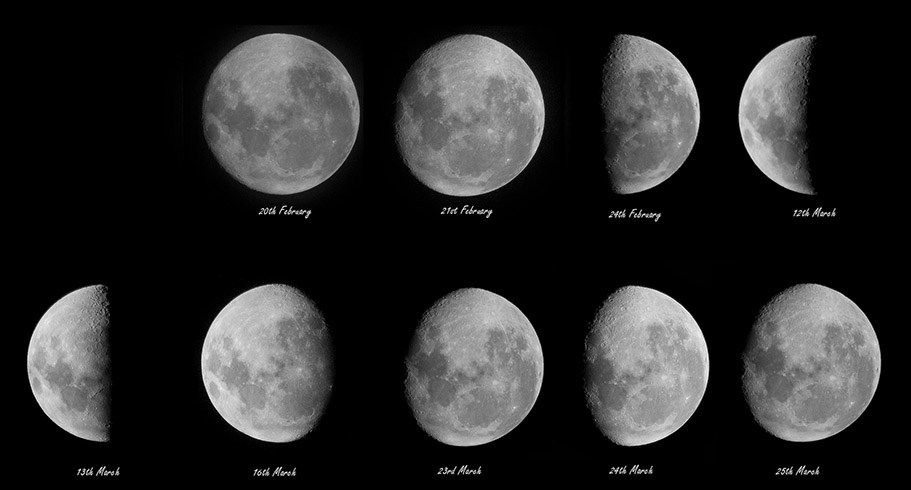The Phases of the Moon

We’ve all looked up at the night sky at one time or another and viewed our natural satellite, the moon. But how the moon appeared has everything to do with what phase it was in. Let’s take a look at how the moon changes it appearance during its lunar calendar.
The moon orbits Earth at about 382,400 kilometers and takes 29.53 days to cycle through its lunar month, which is why we see the moon in various phases. Just like Earth is lit only half of the time by the Sun, so is the moon. The phases we view of the moon is due to the angle it makes with the Sun when viewed from Earth. We really only see the moon because sunlight is reflecting off of this orb and reflecting it back to us.
Nigel Howe from Sydney, Australia, CC BY 2.0, via Wikimedia Commons
The Four Main Moons
The moon has four main phases; the New Moon, the Full Moon, the First Quarter and the Third Quarter.
The New Moon
When the moon is in this phase, we cannot see it here from Earth. This is because the moon is positioned between the earth and sun. When they are in approximate alignment, the entire illuminated portion of the moon is on its backside, the half that we cannot see.
The Full Moon
The striking beauty of a full moon is again due to the Earth, Sun and moon being in approximate alignment; however the moon is on the opposite side of the Earth and therefore can be fully illuminated by the Sun.
The First Quarter and Third Quarter Moon
Also known as Half Moon, this is when the moon is at a 90 degree angle with respect to the Earth and Sun. So we are seeing exactly half of the moon lit up and the other half in its shadow.
Now that we know the main phases we can add in the other phases our moon shows or the in between phases of our four main ones. These are;
- Crescent: when the moon is less than half lit
- Gibbous; when the moon is more than half lit
- Waxing: the Moon is expanding its illumination
- Waning; the Moon is “shrinking” or decreasing in “size”
If you really want to impress your friend and family with your moon knowledge you can add the phases together, for example;
- Waxing Crescent; after the new moon, the sunlit portion is increasing, but is still less than half
- Waxing Gibbous: after the first quarter, the sunlit portion is still increasing and is more than half
- Waning Gibbous. after the full moon, then the light continually decreases.
- Waning Crescent; follows the third quarter, which then wanes until the light is completely gone (back to the New Moon).
The phases of the moon are quite fascinating, but did you know that each month’s Full Moon has a very specific name? Check them out.
January Moon After Yule, Wolf Moon, or Old Moon
February Snow Moon or Hunger Moon
March Sap Moon, Crow Moon, or Lenten Moon
April Grass Moon or Egg Moon
May Milk Moon or Planting Moon
June Rose Moon, Flower Moon, or Strawberry Moon
July Thunder Moon or Hay Moon
August Grain Moon or Green Corn Moon
September Fruit Moon or Harvest Moon
October Harvest Moon or Hunter’s Moon
November Hunter’s Moon, Frosty Moon, or Beaver Moon
December Moon Before Yule or Long Night Moon.
If you are looking for a cool way to demonstrate the phases of the moon with your kids, check out this YouTube Video that uses a lamp, a foam ball and a pencil…very cool.
Whether we pay attention or not, the moon has been going through its phases since the dawn of time. This month be sure to take a look at the moon and note the phase it is currently cycling through. It’s fun, free and very fascinating.
